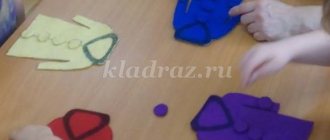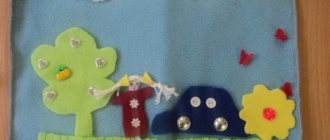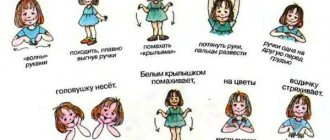Card games for developing fine motor skills
- I’ll draw a berry - the children outline the contours of the berries drawn on a sheet of paper with small beads.
- Needles - the child should roll a hair brush (round) in his palms, imagining that these are needles from a Christmas tree.
- Guess the letter - two teams of guys. Each one sculpts a letter given by the teacher. Then the children take turns and, with their eyes closed, must determine by touch what letter their opponents have made.
- Snow made of napkins - children are given a napkin each. You need to tear it into small pieces with your fingers to make snow, without helping with your other hand. The one who finishes it the fastest wins.
- Feed the piglet - add legs and a muzzle to the plastic bottle that lies on the table. Ask the children to feed the piglet, putting beans and peas in the neck.
Didactic games for the development of fine motor skills
- Finger travel – houses and places for fingers to move are drawn on a sheet of paper at different ends. You need to walk along the “bumps” with your fingers from one house to another. You cannot tear the first finger off the sheet without moving the second one.
- Colored clothespins – in front of the child there are colorful clothespins and a cardboard circle. The teacher shows how to attach clothespins to cardboard. Then he gives the task to first attach clothespins of the same color, and then the teacher dictates a certain sequence of colors, and the child completes the task.
- Find a surprise - you will need small objects (buttons, seeds, nuts) that need to be wrapped in several layers of candy wrappers. Ask the children to unwrap them.
- Collect stones - put the stones in the sand. Invite your child to collect them using the three fingers of his right hand.
- Scissors – hand your child scissors and paper and offer to cut. If he succeeded, complicate the task with cardboard and drawn lines along which he now needs to cut. Make the level even more challenging by asking you to cut out a shape by drawing lines on paper with a pencil.
Basic tasks for developing motor skills in a baby
Of the large number of different exercises, we will describe some of the more common and effective:
- Finger gymnastic exercises for children aged 4 years and older are the most common exercises, which are characterized by an interesting and exciting form for the child, and therefore allow one to achieve high results. Over time, small props, for example, cubes, should be introduced into gymnastic games.
- It is better to give preference to those exercises where each finger is trained individually, and there are also stages of tension, relaxation and stretching. However, there is no need to overdo it - the load should correspond to the child’s level of physical fitness.
- Be careful when working with children who are characterized by hyperactivity - finger exercises have a very good effect on the tone of the cerebral cortex. If the baby does not show much interest in the lessons, try using cards with images or any other teaching material.
- Regulate the duration of classes. For preschoolers and children over 4 years old, the time to complete the exercises is 15 minutes.
- Regularity will also affect your performance: try to practice every day. And so that the baby doesn’t get bored, choose exercises that can become part of the entertainment, educational process or household chores.
- Sand therapy. The extraordinary influence of sand on the human psyche has been studied for quite a long time, so it is very actively used in the work of many specialists. Activities with sand for children allow not only to develop motor skills, but also to reveal their creative potential. To organize your activities you will need a medium box of sand. Hide a small toy in it, and let the child find it. To make it more difficult, you can use several small objects.
- Tasks with small details. There are a lot of exercises for children using small toys and objects. Buttons, beads, cereals or pebbles will help perfectly here. You can ask the baby to roll the object between his fingers, guess it by touch, press it with pads, etc.
- Another effective exercise for children is cutting out figures using scissors along the contour. You need to start with simple geometric shapes, gradually complicating the task. Teach your child to cut out figures and outlines.
- Origami, namely weaving rugs from paper. Such tasks will be good not only for hand motor skills, but also for improving memory. In addition, by creating paper birds, airplanes, and bows, the baby will be able to develop his creative imagination and perseverance. This activity will be interesting to a child from an early age.
- You can also work together with your little one to prepare your home for the holiday by cutting out flowers, Christmas trees, figures or leaves.
- In addition to paper, straw, willow twigs, veneer, braid and ribbons can be used as materials for weaving rugs. Origami is a very popular activity. This technique is often used by professional psychologists and teachers for the development of children from an early age.
- Application. This lesson is aimed at creating a variety of postcards, pictures and other original compositions. All you need for the lesson is a glue stick, colored paper, cardboard and scissors. By cutting out different shapes from paper, the child will develop fine motor skills, and the combination of different materials will help him fully express his creative abilities.
- Modeling. This is every child's favorite activity. Even kids aged 2 years and older will enjoy sculpting, but only under the watchful eye of their parents. In order to combine business with pleasure, offer your child modeling from plasticine, special clay or salt dough. You can also cover a plate or bottle with plasticine, decorating the product with some natural materials: twigs, grains, nut shells, pistachios. Such jewelry is quite strong and attractive.
- Tasks such as lacing have also become popular. They are divided into narrative ones, for example, fabric ones, as well as light ones - artistic weaving. The first option is an unfinished picture that needs to be completed by attaching the missing piece in the form of laces. Fabric designs are most often represented by a puzzle, the elements of which are connected to each other through lacing. And artistic weaving involves creating a picture on a single object. The base of the composition is made of wood or other safe materials. Such games must include instructions and all the necessary materials. Recommended for children over 3 years old.
- Coloring templates and drawing. This type of activity is especially useful for those children who have developmental deviations such as weak motor apparatus of the dominant hand. In this case, the child may experience weakness in the hand and poor control of movements. The best option for strengthening your writing hand and improving fine motor skills is drawing.
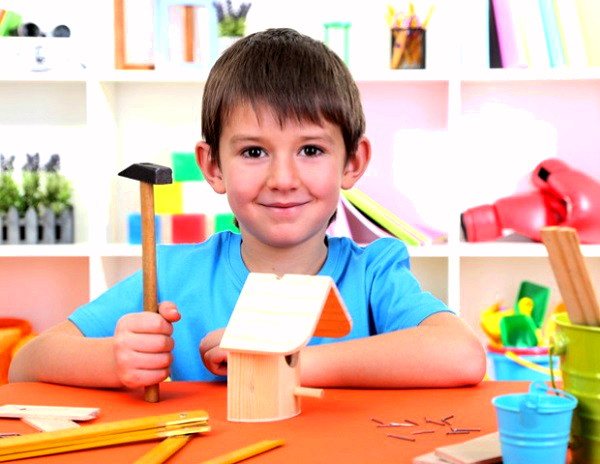
Games for the development of fine motor skills, junior group, 5 games for the development of fine motor skills
- Watchmaker - in front of the child is a tray with cells, a cup with beads and tweezers. The baby must carefully grab the bead with tweezers and transfer it to the cell.
- Beads for the doll - you will need thread and buttons or special wooden beads. Children must string it on a string.
- Colored droplets - prepare an ice tray. Circle the first cells with a red felt-tip pen, the second with blue, and the third with yellow. Place three jars of water of the same colors in front of your child. The baby’s task is to use a pipette to transfer water from the container to the ice tray according to the colors.
- Matryoshka - the teacher rattles a large matryoshka, takes out a medium one from it, and a small one from the middle one. Talks about sizes and compares them. Then he invites the children to collect nesting dolls.
- Search in cereals - objects or toys are hidden in a bowl of cereal that the child needs to find. Pay attention to the child that the cereal should not spill onto the table.
How to develop finger motor skills in preschool age
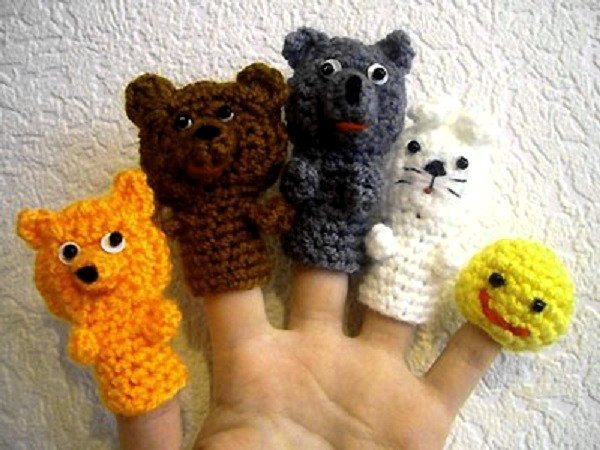
It is useful to do a light massage of the fingers, which has a beneficial effect on the development of speech zones. For preschool children from 5 years old, there are a huge number of tasks, often in the form of rhymes. Such counting rhymes are also great for developing memory. Also, dexterity of movements is developed during independent dressing, putting on shoes, and eating food. It is very important to pay enough attention to the development of fine motor skills of the hands and fingers in the process of preparing the baby for first grade, because during school he will face increased and unusual loads. For classes, you should choose exercises that take into account your child’s inclinations and physical development, so as not to overdo it with the load.
Along with this they search and read:
Features of the physical development of children 3-4 years old and Age-related features of the physical development of preschool children
Games for the development of fine motor skills, middle group, 5 games for the development of fine motor skills
- Game with a pencil - the children are given pencils. You need to place it between your palms and rotate it so that it moves from the tips of your fingers to the bases of your palms. Ask children to hold the pencil so that the ring and index fingers are on top, and the little and middle fingers are on the bottom.
- Rubber band game - Have your child pull a rubber band between their middle and index fingers. Now you need to imagine that children are playing the guitar, fingering the strings (rubber band) with the middle and index fingers of the second hand.
- Magic bag - you need to take two sets of identical toys. One hides in a bag, the second in front of the teacher. The teacher shows the child a toy, and he must feel the same one in the bag and take it out.
- Game with a ball - first let the children roll the ball on the table, pushing it with their left hand and catching it with their right, and vice versa. Then they twirl the ball, holding it with their thumb and middle finger, then with their thumb and forefinger.
- Playing with counting sticks - let the child lay out patterns and geometric shapes from sticks.
How to develop motor skills in preschool children
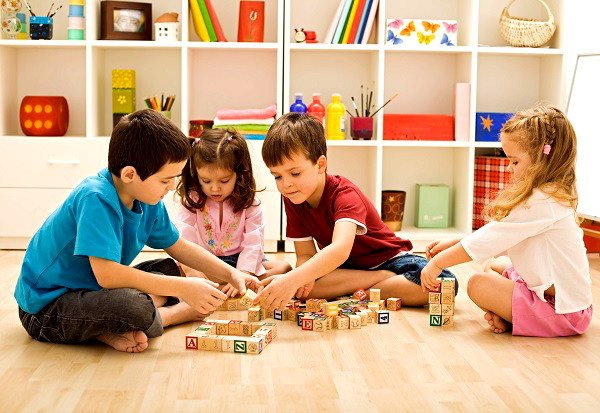
The muscles in the hands are responsible for hand motor skills. Every responsible parent knows how important it is to develop motor skills in young smart people of preschool and primary school age. But not everyone knows how to work with their children. There are many systems and exercises that allow you to develop the motor skills of children's hands in accordance with age requirements.
Moreover, if you do not work on problematic motor skills of the hands and fingers, then even minor everyday tasks will be difficult for the child. Thus, special exercises will allow you to quickly learn how to tie shoelaces on sneakers and fasten buttons on a coat. In addition, the skills acquired will help you learn to hold a brush or pencil more confidently, which is important in preparing for first grade.
There is another important aspect. The centers responsible for motor skills and active speech are located in the brain in close proximity to each other and interact with each other. Accordingly, by developing one center, we develop neighboring ones, and this only has a positive effect on the overall development of your child.
Games for the development of fine motor skills senior group, 5 games for the development of fine motor skills
- Color it correctly - give the children images of geometric shapes and show them how to shade them (straight, tilted to the right and left).
- Paper crafts - teach children to make simple shapes, a cap or a boat out of paper.
- Shadow theater – create a theater in a shadowed room with a light source. Teach children to make shapes from their fingers and assign them roles.
- Cinderella - mix two types of cereals, give the children two containers and ask them to sort through the cereals, separating them.
- The letter grows - a large letter is drawn in one part of the sheet, and a small letter in the other. Ask your child to show how the letter grows by writing the same letter a little larger next to the small one and gradually increasing it until it grows into a large one.
Games for the development of fine motor skills preparatory group, 5 games for the development of fine motor skills
- Roll up the ribbon - there are two ribbons on a stick, attached to it at one end. They need to be rolled up quickly.
- Make it out of matches - give the children figures and ask them to make them out of sticks or matches inside.
- Patterns from threads - according to the sample cards, the children must lay out certain knots and patterns, loops from threads. When children learn, you can play without models.
- Remember - the teacher lays out a pattern from counting sticks, the child looks at it for several seconds. Then you need to repeat this pattern from memory using sticks.
- On skis - place plastic bottle caps on the table and hit them with your middle and index fingers. Simulate skiing on a table, avoiding obstacles.
When playing games, pay attention to the frequent use of small objects. Be careful that small children do not swallow them or place them where they are not supposed to. Allow children to play only under the supervision of an adult.
